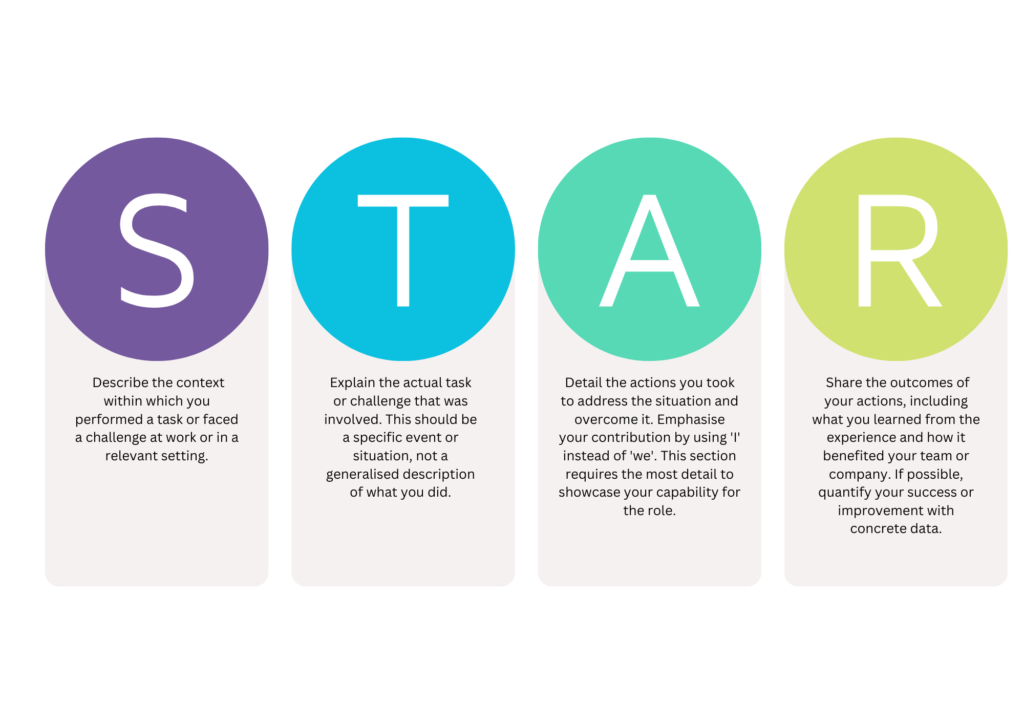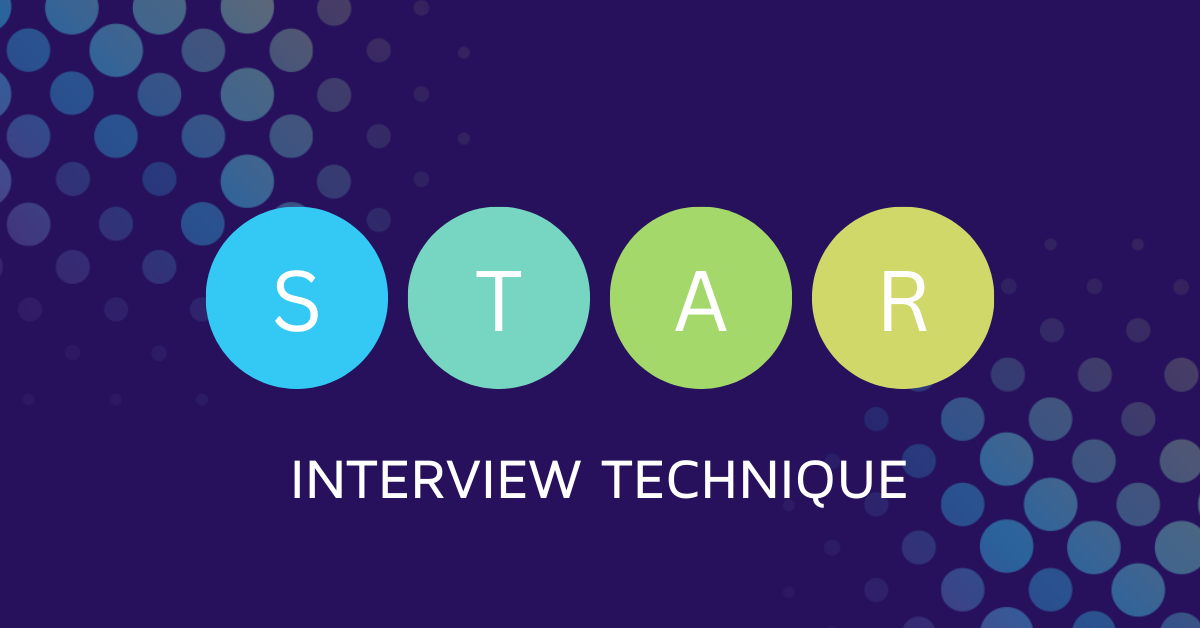What is the STAR interview technique?
The STAR interview method is a technique used to prepare for behavioural and situational interview questions. STAR stands for:
- S – Situation
- T – Task
- A – Action
- R – Result
These kinds of questions are asked by interviewers to determine whether you are the right fit for the role and how you would handle certain situations you might face if chosen. We have put together this article to help you better understand the method and to show you how to put this into practice in your next job interview.

When to Use the STAR Interview Technique
You can use the STAR method in your:
- CV
- Cover letter
- Application form – usually in a further information section
- Interview
How Does It Work?
The STAR interview technique simplifies creating a response that flows, demonstrating clear conflict resolution. Here is what each part entails:
- Situation: Start by setting the scene with background information on a specific challenge or situation you faced. Mention key points about related work experience, academic projects, or voluntary activities. Keep this section brief, as interviewers are more interested in the actions you took and the outcomes achieved.
- Task: Describe your responsibility in the situation. Explain the goal and the tasks set for you, using one or two main points to best articulate the task. This section should also be concise.
- Action: Detail the actions you took to address the situation and overcome it. Emphasise your contribution by using ‘I’ instead of ‘we’. This section requires the most detail to showcase your capability for the role.
- Result: Share the outcome of your actions. Highlight two or three main achievements, what you learned, and how the experience strengthened you. Provide concrete evidence of the results. This section should be detailed but slightly shorter than the action section.
Preparing Your STAR Interview Technique Response
Not sure how to prepare your STAR interview question responses? Follow the step-by-step guide below:
- Read the job advert thoroughly to identify key skills and challenges associated with the role. Reflect on past experiences relevant to these challenges.
- Review typical behavioural interview questions to familiarise yourself with their essence, which tends to remain consistent across interviews.
- Reflect on your professional experiences where you’ve demonstrated the qualities needed for the role and structure these reflections following the STAR format.
- Rehearse your responses aloud for clarity and to boost confidence, making your delivery sound natural during the interview.
If you lack extensive work experience, draw from internships, voluntary activities, or group projects from your studies. Consider personal challenges you’ve successfully navigated for personal example questions.
Clearly outline the situation, task, action, and result, focusing on showcasing skills and competencies that make you a perfect fit for the job. Following these steps, you’ll be well-prepared to present your experiences during your interview.
STAR Interview Technique Question Examples
While you won’t know the exact questions ahead of time, most behavioural questions will focus on work-related challenges, critical thinking, problem-solving, and leadership skills. Here are a few examples of common behavioural questions you might encounter:
- Can you give an example of a challenging issue at work and how you resolved it?
- Have you ever made a decision that wasn’t well-received? How did you manage the situation?
- Describe a time you were under a lot of pressure. What was your response?
- Discuss a mistake you’ve made and how you addressed it.
- Can you provide an example of a difficult decision you faced? How did you proceed?
Examples of Responses
Here are some examples of responses to popular behavioural interview questions using the STAR method:
Example 1: Share an example of a time when you faced a difficult problem at work. How did you solve this problem?
- Situation: As an Account Executive, I encountered a critical service disruption affecting several clients, raising concerns about our reliability.
- Task: My primary goal was to manage this crisis efficiently, ensuring swift resolution and maintaining client trust.
- Action: I coordinated with our technical team for updates on the disruption’s resolution and communicated these updates to clients via email and calls, discussing compensation for the inconvenience.
- Result: My proactive approach quickly resolved the issue, with transparent communication and customised compensation helping to retain and even strengthen client relations. Post-resolution feedback highlighted appreciation for our handling, enhancing our reputation as a reliable, client-focused company.
Example 2: Describe a time when you were under a lot of pressure at work. How did you react?
- Situation: In my role as a Project Manager, we faced the final stages of a major project when two key team members fell ill, with the deadline only a week away.
- Task: I needed to ensure the project’s timely completion while maintaining team morale and managing client expectations under stress.
- Action: I reallocated tasks among remaining team members based on their strengths and negotiated a slight deadline extension with the client, assuring them of our commitment.
- Result: This strategy allowed me to successfully deliver the project within the new timeline, impressing the client and leading to further collaborations. This experience highlighted the importance of adaptability, teamwork, and clear communication.
Example 3: Tell me about a mistake you’ve made. How did you handle it?
- Situation: As a Marketing Specialist, I launched a major email campaign with broken links due to insufficient checks before launch.
- Task: My aim was to execute the campaign successfully to increase engagement, but this error jeopardised our reputation and campaign success.
- Action: After informing my supervisor, we issued an apology email with correct links and refined our review process to prevent similar errors, adding extra verification steps.
- Result: The quick correction and transparency mitigated potential negative impacts, leading to an improved process for future campaigns and emphasising the importance of detail and proactive problem-solving.
By employing the STAR format, you demonstrate your experiences in a clear, impactful manner, highlighting problem-solving skills, adaptability, and teamwork. Preparation, including selecting relevant examples and practising your delivery, will make your responses stronger.
Mastering the STAR interview technique can better your interview performance, allowing you to confidently present your experiences. Remember, it’s not just about what you’ve done, but how you convey your stories that sets you apart in the job interview process.





